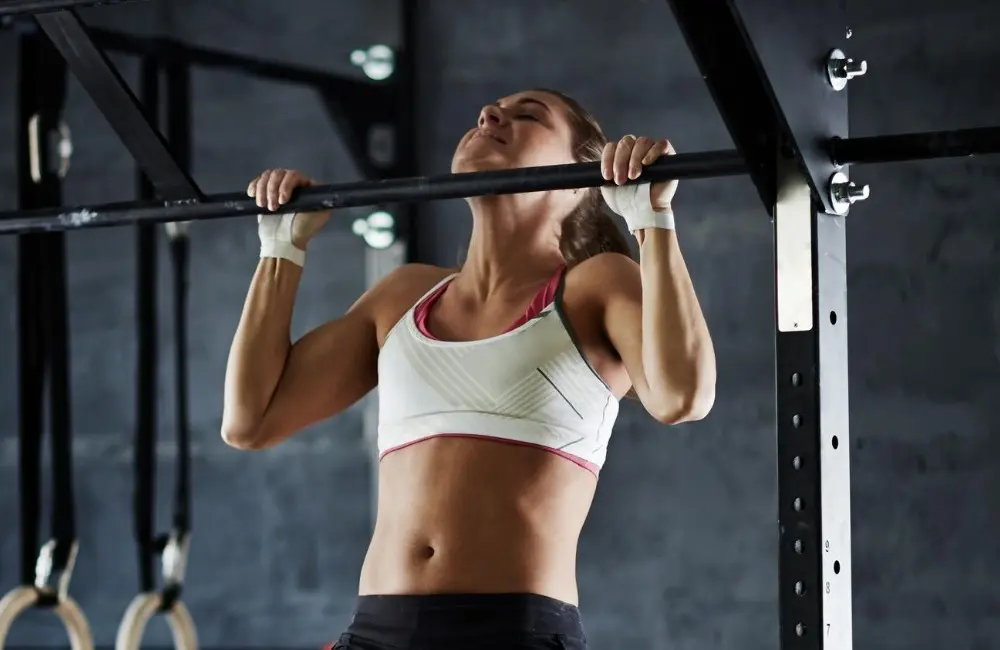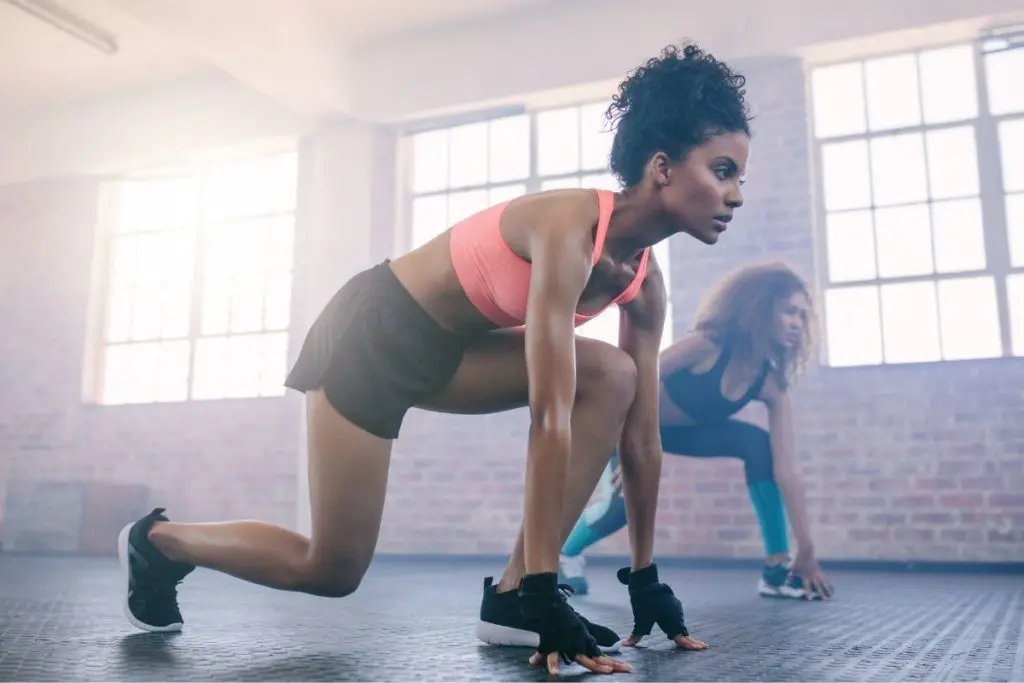Are you wishing upon a star for an exercise that works your entire upper body all at once? Your wish has come true! That exercise exists, and it’s called a pull-up — cue fairy godmother music. In this article, let us be your little green cricket, telling you all about this magical compound exercise. We’ll cover the proper form and benefits of pull-ups every day.
You’ll also find features on the benefits of pull-ups for women, benefits with weights, and benefits of assisted pull-ups. By the time you finish reading, you’ll have the information you need to master this easy and effective exercise with great results!
What Is a Pull-Up?
Before getting into the benefits of doing pull-ups, let’s start with the basics: what is a pull-up, and what is proper pull-up form and grip.
Like we said in the introduction, pull-ups are a compound exercise. This term means they work several muscle groups all at once. Best of all, pull-ups are super easy and convenient. All you need is a pull-up bar.
But really, all you need is something like a bar or ledge that you can safely grab hold of, and that will safely support your weight. That could be the monkey bars at your local park or even an extra-sturdy tree branch.
Once you’ve found your spot, here’s how to do a pull up:

- With a grip slightly wider than shoulder-width, grab the bar with your hands facing away from you — hands toward you means you’re doing a chin up. Chin-ups are also a great exercise, but they work your arms a bit more than your back.
- Next, hang from the bar, fully extended.
- Pull yourself up. Chin above the bar! Don’t go halfway — and once your chin is above the bar, pause for a beat.
- Lower yourself back down to full extension.
And that’s pretty much all there is to it!
Benefits of Doing Pull-Ups
Pull-ups target the following muscle groups:
- Arm muscles
- Shoulder and back muscles
Specifically, pull-ups work the large back muscles, like the latissimus dorsi, and shoulder muscles. They also target the deltoid, or the rounded, outer part of your shoulder, and the trapezius, or your shoulder-shrugging muscles. Pull-ups also work those suns-out-guns-out bicep muscles in your arms, according to the American Council on Exercise.
And yes, pull-ups also engage your abs as they stabilize your core while pulling your chin up and over the bar.
For best results, do pull-ups regularly. You’ll see improved upper body strength, as well as increased endurance and gripping power. Pull-ups can even improve your posture, and — like lots of other forms of exercise — they can help improve your overall mental and emotional health.

All pumped and ready to go try a pull-up? Good. We applaud your enthusiasm. Are you wondering about the benefits of doing pull-ups every day? We’ll go over that next.
How Often Should I Do Pull-Ups?
We’re here to say, think twice before adding pull-ups to your daily workout routine. Here’s why.
Like any resistance exercise, it’s essential to give yourself a while to recover between workouts. But don’t just take our word for it. The National Strength and Conditioning Association, and the Journal of Applied Physiology say so, too.
You should rest between resistance training because you’ve got to give some time for inflammation in your muscles to subside. Experts recommend resting at least 24 to 48 hours between heavy workouts.
So how often should you do pull-ups?
To stay safe and for best results, experts recommend working pull-ups into your routine 3 or 4 days a week. It’s a little more difficult to answer how many pull-ups you should be doing at a time. A lot depends on your body type and overall fitness level.
A general guideline, though, is that men in good physical condition should be able to do about 8. A fit woman should be able to do about 3. To find the number that’s right for you, begin with one and go from there.
Tried a pull-up, and you can’t quite get one? That’s ok! It can take a while to build enough upper body strength.
In the meantime, try an assisted pull up. We’ll tell you everything you need to know about assisted pull-ups, the benefits of assisted pull-ups, and how to perform an assisted pull-up, next.
Benefits of Assisted Pull-Ups & How to Try One
If you don’t quite have the upper body strength to do a pull-up, start with an assisted pull up to exercise the same muscle groups while also building strength.

An assisted pull up is nothing more than a regular pull up with an added boost, helping lessen your body weight to the point that a pull up becomes manageable.
There are machines that help with assisted pull-ups, but this extra help can take many forms. Here are just a few of the most common:
Use a Chair
Place a chair under your pull up bar and put one or both feet on the chair for a little extra help getting your chin up and over the bar. It’s important to keep using as much upper body strength to perform the pull up as possible without relying too much on your feet and legs.
Try Exercise Bands
Another way to perform an assisted pull up is with an exercise band.
To perform an assisted pull up with an exercise band, wrap the exercise band around the bar. Here’s how:
- Loop the band around the bar.
- Pull it through itself and pull the band taut.
- Be sure to work out any twists or kinks in the band.
- Step one or both feet into the loop you’ve just made, and let the band assist you with some of your body weight while performing a pull-up.
Exercise bands come in various sizes and strength levels, so it’s important to find one that’s right for you. Or, instead, pick up a variety pack.
Find a Work-Out Buddy
Another way to try an assisted pull up is with a partner. To perform a pull up with a partner, have them hold your feet to provide just the slightest amount of boost.
It’s essential your partner doesn’t give you too much help, just enough to get your chin up and over the bar while continuing to target all the right muscle groups to build body strength. The objective is that one day you’ll be able to do a pull up all on your own.
Speaking of upper body strength, women can tackle any kind of exercise as men, and women will absolutely benefit from pull-ups just as much as men do. Some women do have less upper body strength than men. It can take a little bit longer for them to build enough power to perform a pull-up.
This doesn’t mean women can’t or shouldn’t do pull-ups. On the contrary, this exercise can be even more effective for women!
We’ll talk about the benefits of pull-ups for females with some pointers for women still mastering the exercise.
Tips for Women and Pull-Ups
Pull-ups target all the same muscle groups in women as they do in men.

We’ve already been over-assisted pull-ups, so if you’re a woman struggling with the upper body strength to perform a pull-up, start there.
But there are a few tips and tricks for women that have been found useful. We’ll go over those now:
- While attempting a pull-up, it’s helpful for some women to imagine pulling down on the bar toward their upper chest.
- While doing so, they also picture driving their elbows down towards the ground.
- It’s also essential to keep abs and glutes tight at all times.
- And like other forms of resistance training, remember to exhale throughout the pulling portion of the exercise.
Just because pull-ups can sometimes be a little tougher for women, it doesn’t mean women shouldn’t try, or that one day, they won’t be able to do just as many pull-ups as the guys.
Most of all, it’s important for women not to give up when it comes to pull-ups. In fact, experts recommend for best results that women should practice pull-ups as often as 3–5 times a day and at least 3 days a week.
Have you mastered pull-ups, and are you now seeking a little extra challenge? If that’s you, try adding weights to your workout. More on that, next.
Benefits of Weighted Pull-Ups
A weighted pull-up is like any other pull up, with added weight to increase the difficulty. Weighted pull-ups work all the same muscle groups, with even better results, particularly in your abs.
There are a few ways to add extra weight. Here are some of the most common:
- Dip belt
- Weighted vest
- Chains
- Placing a dumbbell between the feet or legs
- Looping a kettlebell over the foot
It’s also important to note: weighted pull-ups are an advanced exercise, so beginners beware.
To evaluate whether or not you’re ready for a weighted pull-up, we recommend having a trainer watch you do 10 bodyweight pull-ups. If you can handle 10 bodyweight pull-ups with ease, you could be ready to add some weight.
There are also a few technique differences to execute a weighted pull-up successfully.
First, vary your grip, try a grip that’s a bit wider than usual. Second, and most importantly: don’t forget to rest between sets.
And there you have it. Pull-ups are a great compound exercise to build upper body strength. They’re not easy for everyone to master. With proper form, and by beginning with an assisted pull up, anyone can master this simple and effective form of exercise.
Further Reading






